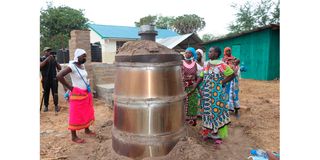Kwale: The new technology giving charcoal burners a lifeline

Kwale women charcoal producers harvesting their product from the portable metallic kiln at the Mtwapa Energy Centre.
What you need to know:
- Kwale County has borne the brunt of logging and charcoal burning.
- The government and a wildlife conservation organization, has intervened to help in conservation and improve the livelihood of Kwale farmers.
- 100 Kwale charcoal burners, especially women, were trained on alternative sources of energy and modern charcoal burning.
Kwale farmers have not harvested anything substantial from their farms in the last three years.
And now the prolonged drought is taking a heavy toll on locals, forcing residents to turn to forests where they cut down trees and burn charcoal to earn a livelihood.
However, the wanton destruction of the depleted forests has forced the government and World Wide Fund (WWF), an international wildlife conservation organization, to intervene and help in conservation and improve their livelihood.
Kwale forest cover stands at only 5.2 per cent.
Kenya Forest Service (KFS) Kwale manager Blessington Maghanga, says the county has borne the brunt of logging and charcoal burning.
He, however, notes that there are efforts to deal with individuals cutting down the trees. Charcoal burning is rampant in Samburu, Kinango and Lunga Lunga, which are arid areas.
"We need to plant trees in those areas. Our forest cover is low, we are required to be at 10 per cent. In Kwale, we have ranches, public and Kaya forests. We have 12 community forest associations and charcoal producers’ associations," Mr Maghanga says.
For close to 12 years, Sanita Charo has been burning charcoal and selling a 90kg bag at Sh400. The 36-year-old mother of six, says she used to get a profit of Sh3,000, but in 2017 when the government banned charcoal burning and logging in public forests, her world crashed.
Life challenges pushed her into charcoal burning to make ends meet.
After completing her primary education 15 years ago, Ms Charo got married due to poverty that engulfed her family in the drought-stricken Kinang’o area of Kwale County.
Her dreams of joining secondary school were thwarted when her parents told her they could not afford to educate her.
“It was a living hell. Charcoal has been my source of revenue, that’s why the ban affected me. Charcoal burners in Kinango, where drought and famine hit us hard every year, could not make ends meet, our children had to drop out of school due to lack of fees,” she says.

Sanita Charo is among those who have been empowered to produce biogas, tap into solar energy and modern charcoal burning to conserve the environment.
When her charcoal was ferried to Mombasa, the middlemen who are the main profiteers, sold a 90kg bag at Sh1,800.
Ms Charo is among the thousands of Coast residents who were dependent on the charcoal business before the ban. With no source of revenue, biting famine and hunger, the residents have been left poverty-stricken.
Mr Maghanga urges Kwale residents to embrace new technologies and afforestation programs in their homes to conserve the environment. He warns burners against invading ranches to burn charcoal as that scares away wild animals.
“In arid areas of Kwale, we have high calorific value tree species of acacia trees, which should be planted. For four years, Kwale residents have not been able to harvest anything from their shambas forcing them to turn to the forests to earn their livelihood.
“However, we want sustainability and conserving our forests. They have been harvesting trees due to the drought but we want to ensure tree plantation is enhanced through nurseries," he says.
He urges residents to enhance tree plantation and protection for natural regeneration to boost forestry.
Penina Kitsao, 70, from Lunga Lunga says she decided to venture into the forest due to starvation. Her five goats died as a result of drought.
But their saving grace arrived when WWF regrouped them and began training them on alternative sources of energy, agroforestry and environmental conservation to improve their livelihoods and uplift their standards of living.
Chairman of the Kwale charcoal producers Chakama Mtunda, says the sector has employed thousands of the residents.
“Sadly though, our source of livelihood has led to the depletion of our forests due to deforestation, logging and charcoal burning, thus destroying our environment. Our work is risky now that logging and charcoal burning was outlawed,” he adds.

Kwale women charcoal producers carrying a log that they used to produce charcoal at the Mtwapa Energy Centre during their training.
Speaking to nation.africa at Mtwapa Energy Centre where the 100 Kwale charcoal burners, especially women, were trained on alternative sources of energy and modern charcoal burning, Mr Mtunda said they have embraced the new technology to conserve the environment.
“Instead of cutting down a trunk, we will be cutting the branches and twigs, especially matured trees then give it time to grow again. We can also use leaves to make charcoal. We were told to use fully dried logs to produce charcoal. WWF later took us to Tanzania to learn from our counterparts on how they conserve the environment, afforestation and agroforestry,” he adds.
Mr Mtunda says Tanzanians have embraced conservation and afforestation, which has been beneficial to charcoal producers in the neighbouring country.
Pastor Johnson Ziro, began planting trees on his acre farm in Mackinnon where he produces charcoal from twigs.
“I am glad I began a forest in my farm where I use the twigs to produce charcoal. We can do our bit in conserving the environment through planting trees, especially fruit trees,” says Mr Ziro.
Ms Chao says they also learned how to make biogas digester using manure instead of relying on charcoal.
“In Kwale, majority of the residents rear cattle because crop farming cannot thrive due to drought and lack of rains. We can now use our manure to produce biogas and tap into the solar energy,” she adds.
WWF empowered the charcoal producers with a portable metallic kiln to produce charcoal.
Mtwapa Energy Centre is under the Ministry of Energy to promote green energy resources.
WWF officer Neema Suya says they target women because they are the backbone of society.
“We have empowered women from Lunga Lunga, Kinango and Samburu, to be able to provide for their families without relying on their husbands,” says Ms Suya.

The charcoal burners are trained on latest charcoal burning technologies that include portable metallic kiln and Adams Retort. They are environment-friendly.
Environmental research scientist Emily Kitheka, defends the ban saying it was necessitated by the wanton destruction of Kenyan forests.
“The ban has given stakeholders ample time to come up with regulations on charcoal burning before it is lifted. However, proper measures must be put in place, Kenyans sensitised on afforestation, reforestation and conservation. But the ban has negatively affected many livelihoods, especially charcoal burners,” she acknowledges.
There are two modern types of charcoal burning, portable metallic kiln and Adam Retort, whose origin is Germany. They are, however, still under patent.
A medium-size portable metallic kiln costs Sh200,000.
“You just put in your dried logs, light on the fire and wait for 48 hours for your charcoal. It produces the best charcoal, which is unadulterated,” Ms Kitheka says, noting that it is locally made.
“For Adam Retort, the Ministry of Energy collaborated with the owner whose name is Adam Retort, to get his technology, which we are in the process of patenting. We have only four Adam Retort charcoal machines in Kenya,” she adds.
She says Adam Retort produces quality and quantity charcoal.
“The traditional earth kilns take weeks to produce charcoal, they are not environment friendly and produce less. The two modern methods are the best,” observes Ms Kitheka.
She says 100 tons of logs could produce 150 kg of charcoal using traditional earth kilns. However, with modern technologies you can get 350kgs in 48 hours.





